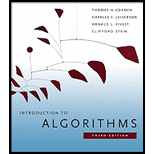
Concept explainers
(a)
To describe how the function reverses that run in
(a)
Explanation of Solution
The reverse operation is performed by using two arrays. Consider another array and copy the elements in the reverse order to the new array from the original array. The operation is performed as swapping the values with the same index in the both array.
After swapping the element to current index it required to set the entry in the second array corresponding to the bit-reverses.
Since the swapping of the element time is depends upon the number of element so suppose there are n -elements in the function of k bit reversed
(b)
To describe an implementation of the BIT-REVERSED-INCREMENT procedure that allows the bit-reversal permutation on an n -element to perform in
(b)
Explanation of Solution
The pseudo-code of the BIT-REVERSED-INCREMENT implementation is given below:
REVERSED-INCREMENT( a )
Set
while m bitwise-AND
shift m right by 1.
end while.
return m bitwise-OR a.
end
The algorithm swaps the value of binary counter and reversed counter so it updates the values by incrementing the counter variable.
The operation is performed is carried out bit by bit so it consider one bit at the time to compared and reversed the values.
The BIT-REVERSED-INCREMENT operation will take constant amortized time and to perform the bit-reversed permutation requires a normal binary counter and a reversed counter.
(c)
To explain how shifting any word shift left or right by one bit in unit time without changing the run time of the implementation.
(c)
Explanation of Solution
The procedure uses single shift so the complexity of the procedure is not changed as any words shift left with unit time.
The procedural is based on the number of bit swapped not on the operation therefore any change in the operation such as type of shift does not affect the time complexity of the procedure.
Since, the operation time is depends upon the number of element so the running time is equal to the product of n and k , where n is the size and k is shift bit.
Hence, there is no change in the running time of implementation.
Want to see more full solutions like this?
- Please solve and answer the questions correctly please. Thank you!!arrow_forwardConsidering the TM example of binary sum ( see attached)do the step-by-step of execution for the binary numbers 1101 and 11. Feel free to use the Formal Language Editor Tool to execute it; Write it down the current state of the tape (including the head position) and indicate the current state of the TM at each step.arrow_forwardI need help on inculding additonal code where I can can do the opposite code of MatLab, where the function of t that I enter becomes the result of F(t), in other words, turning the time-domain f(t) into the frequency-domain function F(s):arrow_forward
 C++ Programming: From Problem Analysis to Program...Computer ScienceISBN:9781337102087Author:D. S. MalikPublisher:Cengage Learning
C++ Programming: From Problem Analysis to Program...Computer ScienceISBN:9781337102087Author:D. S. MalikPublisher:Cengage Learning EBK JAVA PROGRAMMINGComputer ScienceISBN:9781337671385Author:FARRELLPublisher:CENGAGE LEARNING - CONSIGNMENT
EBK JAVA PROGRAMMINGComputer ScienceISBN:9781337671385Author:FARRELLPublisher:CENGAGE LEARNING - CONSIGNMENT C++ for Engineers and ScientistsComputer ScienceISBN:9781133187844Author:Bronson, Gary J.Publisher:Course Technology Ptr
C++ for Engineers and ScientistsComputer ScienceISBN:9781133187844Author:Bronson, Gary J.Publisher:Course Technology Ptr New Perspectives on HTML5, CSS3, and JavaScriptComputer ScienceISBN:9781305503922Author:Patrick M. CareyPublisher:Cengage Learning
New Perspectives on HTML5, CSS3, and JavaScriptComputer ScienceISBN:9781305503922Author:Patrick M. CareyPublisher:Cengage Learning Programming with Microsoft Visual Basic 2017Computer ScienceISBN:9781337102124Author:Diane ZakPublisher:Cengage LearningProgramming Logic & Design ComprehensiveComputer ScienceISBN:9781337669405Author:FARRELLPublisher:Cengage
Programming with Microsoft Visual Basic 2017Computer ScienceISBN:9781337102124Author:Diane ZakPublisher:Cengage LearningProgramming Logic & Design ComprehensiveComputer ScienceISBN:9781337669405Author:FARRELLPublisher:Cengage





